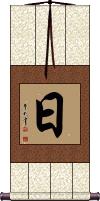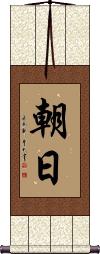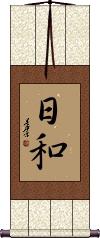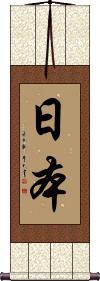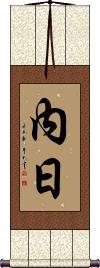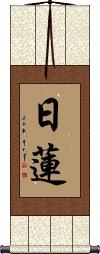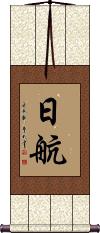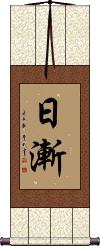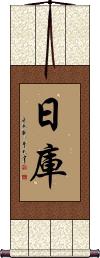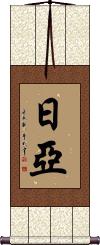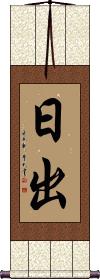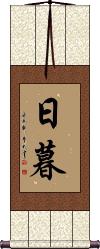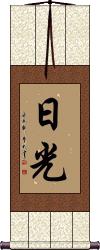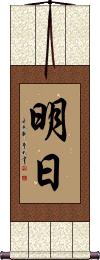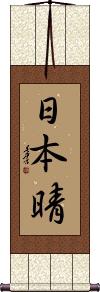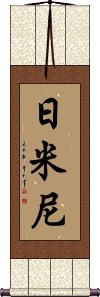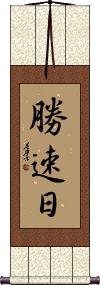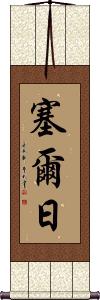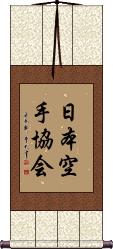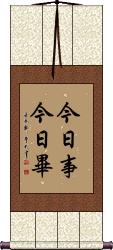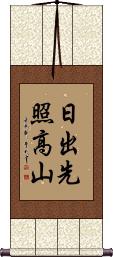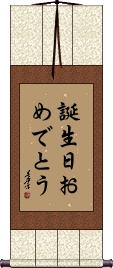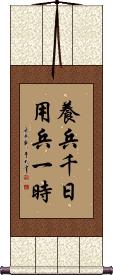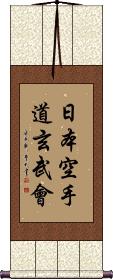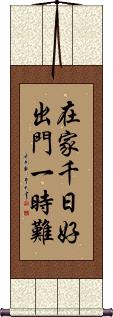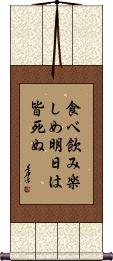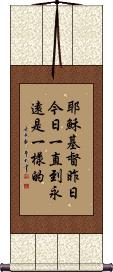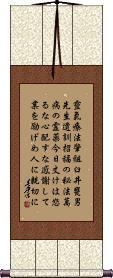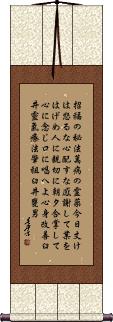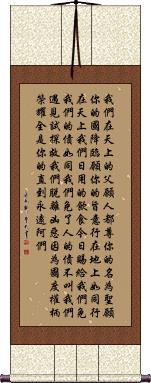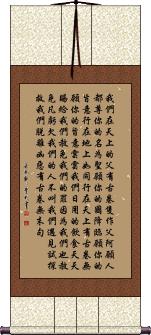Many custom options...
And formats...

日 in Chinese / Japanese...
Buy an 日 calligraphy wall scroll here!
Personalize your custom “日” project by clicking the button next to your favorite “日” title below...
1. Day
2. Sun / Solar
4. Hiyori
5. Japan
6. Neige
7. Nichiren
8. Nikko
10. Riku
11. Riya
12. Sunrise
16. Angele
18. Geminy
19. Geneva
20. Germain
21. Germaine
22. Katsu Hayabi
23. Lisange
24. Lysange
25. Nadege
26. Niger
27. Rizuan
28. Sarina
29. Serge
30. Sun Moon Stars
31. One Day Seems Like 1000 Years
32. Carpe Diem / Seize the Day
33. Edwige
34. Everyday Life
35. Gersendre
37. Grzegorz
38. Happy Birthday
39. Marie-Ange
40. Marie-Neige
41. Nigeria
42. Nihon Jujitsu
43. Nippon Kempo
45. Blanche-Neige
46. Efigenia
47. Gertrude
50. Nihon Karate-Do
52. Japanese Karate Association
53. Kasprzycki
54. Never put off until tomorrow what you can do today
56. When the sun rises it first shines on the highest mountain
57. Happy Birthday
58. Maintain An Army For 1000 Days, Use It For An Hour
59. Nippon Karate-Do Genbu-Kai
61. Eat Drink and Be Merry, For Tomorrow We Die
62. Hebrews 13:8
63. The Five Principles of Reiki
64. The two most important days in your life...
65. Reiki Precepts by Usui Mikao
This is how to write “day” in Chinese, Japanese, and Korean Hanja.
This can also mean “Sun,” the star in the middle of the Solar system in which we live. In Japanese, it can also mean “sunshine” or even “Sunday.”
When writing the date in modern Chinese and Japanese, putting a number in front of this character indicates the day of the month. Of course, you need to indicate the month too... The month is expressed with a number followed by the character for the moon. So “three moons ten suns” would be “March 10th” or “3/10.”
Note: This is also the first character for the proper name of Japan. Remember that Japan is “The land of the rising sun”? Well, the first character for Japan means “sun” and the second means “origin” so you get the real meaning now. Sometimes, in China, this sun character can be a short name for Japan or a suffix for something of or from Japan.
Sun / Solar
Also means Day, Sunshine, Sunlight, or Japan
日 is the word for sun.
It also means day and can refer to the day of the month when expressing the date.
Example: October 1st would be “10 Moons, 1 Sun.”
日 is also the first Kanji for the title of Japan (in Chinese, Japanese Kanji, and Korean Hanja). Thus, this character is used as an adjective for things that are Japanese.
Ever heard of Japan being called, “The land of the rising sun”? Well, that's what the full title of Japan means.
Depending on the context, this character can mean Sunshine or Sunlight.
Note: In Japanese, this Kanji has a variety of possible pronunciations. The pronunciation changed depending on context and how this Kanji is combined with other Kanji. When used alone, this is usually "hi" (pronounced like "hee") but sometimes it’s "nichi." When combined, it can be "tsu," "ni," "ka," and a few others.
Asahi / Morning Sun
朝日 is a version of the Japanese name Asahi.
This can also be Ahisa, Asuka, Ashita, or Asaka. This means morning sun and is the name of the famous beer company in Japan.
This would be read as “Zhao Ri” in Mandarin where it means morning sun but is also known to be the Asahi company (maker of beer and other beverages).
Hiyori
Japan
This is the Chinese and Japanese Kanji name for the country of Japan.
日 means sun and 本 means origin. That is how Japan is known as the land of the rising sun (literally the place where the sun originates from).
Neige
Nichiren
日蓮 is the title Nichiren.
This title refers to a Buddhist priest who lived from 1222 to 1282. He is the founder of the Nichiren sect of Buddhism.
According to historical documents, the Nichiren sect was established in 1252. Adding the character 宗 for sect, this would be 日蓮宗 (Nichiren sect), which is also known as the 法華宗 or Lotus sect.
According to Soothill-Hodous...
Nichiren's chief tenets are the three great mysteries 三大祕法, representing the trikāya:
1. 本尊 or chief object of worship, being the great maṇḍala of the worlds of the ten directions, or universe, i.e., the body or nirmāṇakāya of Buddha.
2. 題目 the title of the Lotus Sutra 妙法蓮華經 Myo-ho-ren-ge-kyo, preceded by Namo, or “Adoration to the scripture of the lotus of the wonderful law,” for it is Buddha's spiritual body.
3. 戒壇 the altar of the law, which is also the title of the Lotus as above; the believer, wherever he is, dwells in the Pure-land of calm light 寂光淨土, the saṃbhogakāya.
Nikko
Progress Day by Day
Riku
Riya
Sunrise
日出 is a Chinese, old Korean Hanja, and Japanese Kanji word that means sunrise.
It literally means “sun coming” or “sun arrival.”
Sunset / Twilight
Sunshine / Sunlight
日光 is the Japanese Kanji word for sunshine or sunlight.
This can also be the Japanese female given name Himi.
Tomorrow / The Next Sun
Angele
Beautiful Clear Sky
日本晴 is a Japanese Kanji title that means beautiful weather, clear and cloudless sky, or clear weather.
It's a little odd, but if you literally translated this phrase, it says, “Japanese weather,” as if that was an indication of perfect weather (maybe a little arrogant on behalf of Japan - I've experienced a monsoon there, which was unpleasant).
Geminy
Geneva
Germain
Germaine
Katsu Hayabi
Lisange
Lysange
Nadege
Niger
Rizuan
Sarina
Serge
Sun Moon Stars
One Day Seems Like 1000 Years
一日千秋 is a Japanese and Chinese proverb about missing someone.
一日千秋 is often used to express how hard it is to wait for someone's return or to be away from someone.
Some will translate this as “one day feels like a very long time” or “waiting for someone (something) is hard.”
You might see this romanized as a single word, Ichijitsusenshuu, or as “Ichijitsu Senshuu” from Japanese.
If you break down the characters one-by-one, we get:
一 = one/a
日 = day/sun (can also represent time or date)
千 = 1000/thousand
秋 = autumn/fall
Together, 千秋 can mean “autumn comes thousand times” (or 1000 years). It can also be read as 1000 periods of time.
However, it relays the idea of heartache as you wait for someone you miss.
Carpe Diem / Seize the Day
Edwige
Everyday Life
日常生活 simply means everyday life or regular life.
You can also translate it as “Living day to day.”
Gersendre
One Good Deed Each Day
一日一善 is a Chinese, Japanese Kanji, and old Korean Hanja phrase that suggests doing a good deed each day or doing one good turn a day.
It literally reads, “One Day, One Good (Deed).”
Grzegorz
Happy Birthday
生日快樂 is how to write “Happy Birthday” in Chinese.
The first two characters mean “birthday,” and the second two characters mean “happiness,” or rather a wish for happiness.
Because a birthday only lasts one day per year, we strongly suggest that you find an appropriate and personal calligraphy gift that can be hung in the recipient's home year-round.
Happy Birthday
祝誕生日 is the shortest way to write “Happy Birthday” in Japanese.
The first Kanji means “wish” or “express good wishes,” and the last three characters mean “birthday.”
Because a birthday only lasts one day per year, we strongly suggest that you find an appropriate and personal calligraphy gift that can be hung in the recipient's home year-round.
Marie-Ange
Marie-Neige
Nigeria
Nihon Jujitsu
Nippon Kempo
The Sun, Moon, and Stars
日月星辰 is a title that encompasses all of the heavenly bodies or celestial bodies.
Namely, this includes the Sun, Moon, and Stars of our universe.
Blanche-Neige
Efigenia
Gertrude
Every day is a good day
Nichiren Daishonin
Nihon Karate-Do
Nippon Shorin-Ryu
Japanese Karate Association
Kasprzycki
Never put off until tomorrow what you can do today
Nippon Karate Kyokai
When the sun rises it first shines on the highest mountain
This old Buddhist phrase means, “When the sun rises it always shines first on the highest mountain,” or “When the sun appears, it first casts its light upon the highest mountain.”
This comes from the Avatamsaka Sutra and has been used as the name or portion of the name for temples in Japan and sites in China.
The Buddha's first round of teaching (Avatamsaka period) is likened to the time when the sun rises from the east horizon. When the sun first rises it illuminates the high mountains. In this analogy, the high mountains represent the great Bodhisattvas and/or those most ready to receive enlightenment and liberation.
This can be romanized from Japanese as “Nichi shutsu sen shō kō san,” “Nisshutsu saki teru takayama,” or “Hide temazu kōzan wo terasu yama.” The last one is probably the most common. Ask three Japanese people what they think the pronunciation is, and you will get three different opinions.
Happy Birthday
Nothing could be more true. When I was in the Marine Corps, we trained for years for combat that often lasts only hours.
養兵千日用兵一時 is a Chinese proverb that, also reminds me of a common phrase used in the military to describe combat: “Weeks of total boredom, punctuated with five minutes of sheer terror.”
This may have some roots in Sun Tzu's The Art of War. Though I can not find this passage in his writings.
On the subject of the Art of War, if you have a favorite passage, we can create a custom calligraphy scroll with that phrase.
Nippon Karate-Do Genbu-Kai
Japanese Genbu Karate Club
日本空手道玄武會 is the title for Nippon Karate-Do Genbu-Kai.
A Japanese karate association of the Genbu school.
Note that while this title does make perfect sense in Chinese, it is really a Japanese title. In fact, the first word is “Japanese/Japan.”
If you’d like your martial arts school, dojo or club added to our calligraphy database for easy ordering of a custom calligraphy wall scroll, just contact me.
No Place Like Home
在家千日好出门一时难 is a Chinese proverb that literally means “At home, one can spend a thousand days in comfort but spending a day away from home can be challenging.”
Figuratively, this means “There's no place like home,” or roughly a Chinese version of “Home sweet home.”
Eat Drink and Be Merry, For Tomorrow We Die
Hebrews 13:8
The Five Principles of Reiki
Reiki Gokai
These are the five principles of Reiki.
They translate into English as...
At least for today:
Do not be angry,
Do not worry,
Be grateful,
Work with diligence,
Be kind to people.
Note: Because this selection contains some special Japanese Hiragana characters, it should be written by a Japanese calligrapher.
The two most important days in your life...
人生で一番大事な日は二日ある。生まれた日と、なぜ生まれたかを分かった日 is Mark Twain's quote, “The two most important days in your life are the day you are born and the day you find out why” in Japanese.
Note: Because this selection contains some special Japanese Hiragana characters, it should be written by a Japanese calligrapher.
Reiki Precepts by Usui Mikao (Alternate)
Alternate Version
靈氣療法肇祖臼井甕男先生遺訓招福の秘法萬病の霊薬今日丈けは心配すな感謝して業を励げめ人に親切に is an alternate version of the precepts or tenets of Reiki by Usui Mikao.
It is impossible to be sure which version or versions were actually written by Usui Mikao. This is the less common of the three versions that you might see in the wild.
Here is a breakdown of the characters and a rough translation:
靈氣 療法 肇祖 臼井甕男。
Reiki therapy founder Mikao Usui
先生 遺訓。
Teacher's testament
招福の秘法, 萬病の霊薬。
Invite blessings of [the] secret method, 10,000 illnesses of spiritual medicine.
今日丈けは: 怒るな, 心配すな, 感謝して, 業をはげめ, 人に親切に。
At least for today: Do not be angry, do not worry, be grateful, work with diligence, [and] be kind to people.
Note: Because this selection contains some special Japanese Hiragana characters, it should be written by a Japanese calligrapher.
Reiki Precepts by Usui Mikao
These are the precepts of Reiki that are attributed to Usui Mikao.
Here is a breakdown of the characters and a rough translation:
招福の秘法, 萬病の霊薬。
Invite blessings of [the] secret method, 10,000 illnesses of spiritual medicine.
今日丈けは: 怒るな, 心配すな, 感謝して, 業をはげめ, 人に親切に。
At least for today: Do not be angry, do not worry, be grateful, work with diligence, and be kind to people.
朝夕合掌して, 心に念じ, 口に唱へよ, 心身改善。
Morning [and] evening perform gassho (join hands), [with your] heart/mind in silent prayer, [with your] mouth chant, [thusly] mind [and] body [will] reform/improve.
臼井靈氣療法! -肇祖, 臼井甕男。
Usui Reiki Ryōhō! -Founder, Usui Mikao.
The middle portion of this is often titled, “The Five Principles of Reiki” and makes a nice calligraphy selection by itself. The Japanese text presented here can be considered the more verbose version.
Note: Because this selection contains some special Japanese Hiragana characters, it should be written by a Japanese calligrapher.
The Lord's Prayer / Mathew 6:9-13
Here is the Lord's Prayer in Chinese from Mathew 6:9-13.
The Chinese text with punctuation is:
Part of 6:9 ...我们在天上的父,愿人都尊你的名为圣。
6:10 愿你的国降临,愿你的旨意行在地上,如同行在天上。
6:11 我们日用的饮食,今日赐给我们。
6:12 免我们的债,如同我们免了人的债。
6:13 不叫我们遇见试探,救我们脱离凶恶,因为国度,权柄,荣耀,全是你的,直到永远,阿们。
Note that punctuation is not included in traditional Chinese calligraphy artwork.
From KJV, this is:
Part of 6:9 ...Our Father which art in heaven, Hallowed be thy name.
6:10 Thy kingdom come. Thy will be done in earth, as it is in heaven.
6:11 Give us this day our daily bread.
6:12 And forgive us our debts, as we forgive our debtors.
6:13 And lead us not into temptation, but deliver us from evil: For thine is the kingdom, and the power, and the glory, forever. Amen.
The Lord's Prayer / Luke 11:2-4
Here is the Lord's Prayer in Chinese from Luke 11:2-4.
The Chinese text with punctuation is:
Part of 11:2 ...我们在天上的父,有古卷只作父阿愿人都尊你的名为圣。愿你的国降临。愿你的旨意行在地上,如同行在天上。有古卷无愿你的旨意云云。
11:3 我们日用的饮食,天天赐给我们。
11:4 赦免我们的罪,因为我们也赦免凡亏欠我们的人。不叫我们遇见试探。救我们脱离凶恶。有古卷无末句。
Note that punctuation is not included in traditional Chinese calligraphy artwork.
From KJV, this is:
Part of 11:2 ...Our Father which art in heaven, Hallowed be thy name. Thy kingdom come. Thy will be done, as in heaven, so in earth.
11:3 Give us day by day our daily bread.
11:4 And forgive us our sins; for we also forgive everyone that is indebted to us. And lead us not into temptation, but deliver us from evil.
Not the results for 日 that you were looking for?
Below are some entries from our dictionary that may match your 日 search...
| Characters If shown, 2nd row is Simp. Chinese |
Pronunciation Romanization |
Simple Dictionary Definition |
日 see styles |
rì ri4 jih nchi; chi んち; ち |
More info & calligraphy: Sun / Solar(suffix) (1) (colloquialism) (See 日・にち・2) nth day (of the month); (counter) (2) (colloquialism) (See 日・にち・3) counter for days; (surname) Hiru sūrya; the sun; a day. 蘇利耶. |
日光 see styles |
rì guāng ri4 guang1 jih kuang nikkou / nikko にっこう |
More info & calligraphy: Sunshine / Sunlight(1) sunlight; sunshine; sunbeams; (2) Nikkō (city in Tochigi); (female given name) Himi (日光菩薩); 蘇利也波羅皮遮那 Sūrya-prabhāsana. Sunlight, and 月光 (月光菩薩) Moonlight, name of two Bodhisattva assistants of 藥師 the Master of Healing; Sunlight is the ninth in the Dizang Court of the Garbhadhātu group. |
日出 see styles |
rì chū ri4 chu1 jih ch`u jih chu nisshutsu にっしゅつ |
More info & calligraphy: Sunrise(See 日没) sunrise; (place-name, surname) Hinode |
日和 see styles |
biwa びわ |
More info & calligraphy: Hiyori |
日方 see styles |
rì fāng ri4 fang1 jih fang hinata ひなた |
the Japanese side or party (in negotiations etc) (personal name) Hinata |
日暮 see styles |
rì mù ri4 mu4 jih mu higure ひぐれ |
More info & calligraphy: Sunset / Twilighttwilight; sunset; dusk; evening; (surname) Higure |
日本 see styles |
rì běn ri4 ben3 jih pen nihon(p); nippon(p) にほん(P); にっぽん(P) |
More info & calligraphy: JapanJapan; (surname) Yamatono Japan. Buddhism was introduced there from Korea in the sixth century, and in the seventh from China. |
日漸 日渐 see styles |
rì jiàn ri4 jian4 jih chien |
More info & calligraphy: Progress Day by Day |
日航 see styles |
rì háng ri4 hang2 jih hang nikkou / nikko にっこう |
More info & calligraphy: Nikko(company) Japan Airlines (abbreviation); JAL; (c) Japan Airlines (abbreviation); JAL |
日蓮 日莲 see styles |
rì lián ri4 lian2 jih lien nichiren にちれん |
More info & calligraphy: NichirenNichiren, the Japanese founder, in A. D. 1252, of the 日蓮宗 Nichiren sect, which is also known as the 法華宗 or Lotus sect. Its chief tenets are the three great mysteries 三大祕法, representing the trikāya: (1) 本尊 or chief object of worship, being the great maṇḍala of the worlds of the ten directions, or universe, i. e. the body or nirmāṇakāya of Buddha; (2) 題目 the title of the Lotus Sutra 妙法蓮華經 Myo-ho-ren-gwe-kyo, preceded by Namo, or, 'Adoration to the scripture of the lotus of the wonderful law, ' for it is Buddha's spiritual body; (3) 戒壇 the altar of the law, which is also the title of the Lotus as above; the believer, wherever he is, dwells in the Pure-land of calm light 寂光淨土, the saṃbhogakāya. |
明日 see styles |
míng rì ming2 ri4 ming jih ashita(gikun)(p); asu(gikun)(p); myounichi(p) / ashita(gikun)(p); asu(gikun)(p); myonichi(p) あした(gikun)(P); あす(gikun)(P); みょうにち(P) |
More info & calligraphy: Tomorrow / The Next Sun(n,adv) (1) tomorrow; (n,adv) (2) (あす only) near future; (female given name) Meibi tomorrow |
朝日 see styles |
zhāo rì zhao1 ri4 chao jih asahi あさひ |
More info & calligraphy: Asahi / Morning Sun(company) (place) (surname) (feminine speech) Asahi; (male given name) Noboru |
尼日爾 尼日尔 see styles |
ní rì ěr ni2 ri4 er3 ni jih erh |
More info & calligraphy: Niger |
日內瓦 日内瓦 see styles |
rì nèi wǎ ri4 nei4 wa3 jih nei wa |
More info & calligraphy: Geneva |
日本晴 see styles |
nihonbare にほんばれ |
More info & calligraphy: Beautiful Clear Sky |
一日一善 see styles |
ichinichiichizen / ichinichichizen いちにちいちぜん |
More info & calligraphy: One Good Deed Each Day |
一日千秋 see styles |
ichijitsusenshuu; ichinichisenshuu / ichijitsusenshu; ichinichisenshu いちじつせんしゅう; いちにちせんしゅう |
More info & calligraphy: One Day Seems Like 1000 Years |
尼日利亞 尼日利亚 see styles |
ní rì lì yà ni2 ri4 li4 ya4 ni jih li ya |
More info & calligraphy: Nigeria |
日常生活 see styles |
nichijouseikatsu / nichijosekatsu にちじょうせいかつ |
More info & calligraphy: Everyday Life |
日月星辰 see styles |
jitsugetsuseishin; nichigetsuseishin / jitsugetsuseshin; nichigetsuseshin じつげつせいしん; にちげつせいしん |
More info & calligraphy: The Sun, Moon, and Stars |
日本拳法 see styles |
nipponkenpou; nihonkenpou / nipponkenpo; nihonkenpo にっぽんけんぽう; にほんけんぽう |
More info & calligraphy: Nippon Kempo |
生日快樂 生日快乐 see styles |
shēng rì kuài lè sheng1 ri4 kuai4 le4 sheng jih k`uai le sheng jih kuai le |
More info & calligraphy: Happy Birthday |
日日是好日 see styles |
rì rì shì hǎo rì ri4 ri4 shi4 hao3 ri4 jih jih shih hao jih hibi kore kōjitsu ひびこれこうにち |
More info & calligraphy: Every day is a good dayevery day is a good day |
今日事今日畢 今日事今日毕 see styles |
jīn rì shì jīn rì bì jin1 ri4 shi4 jin1 ri4 bi4 chin jih shih chin jih pi |
More info & calligraphy: Never put off until tomorrow what you can do today |
日出先照高山 see styles |
rì chū xiān zhào gāo shān ri4 chu1 xian1 zhao4 gao1 shan1 jih ch`u hsien chao kao shan jih chu hsien chao kao shan nichi shutsu sen shō kō san |
More info & calligraphy: When the sun rises it first shines on the highest mountain |
π日 see styles |
pài rì pai4 ri4 p`ai jih pai jih |
World Pi Day, a celebration of the mathematical constant π on March 14 each year |
一日 see styles |
yī rì yi1 ri4 i jih hitohi ひとひ |
(n,adv) (1) (dated) one day; (adv,n) (2) (dated) all day (long); the whole day; (3) (poetic term) 1st day of the month; (place-name) Hitoichi A sun, or day from sunrise to sunset. |
七日 see styles |
qī rì qi1 ri4 ch`i jih chi jih nanoka なのか |
(adverbial noun) (1) the seventh day of the month; (2) seven days; (female given name) Nanoka seven days |
三日 see styles |
sān rì san1 ri4 san jih mikkaichi みっかいち |
(1) the third day of the month; (2) three days; (place-name) Mikkaichi 3 days |
不日 see styles |
bù rì bu4 ri4 pu jih fujitsu ふじつ |
within the next few days; in a few days time (adverb) in a few days; at an early date |
Click here for more 日 results from our dictionary
The following table may be helpful for those studying Chinese or Japanese...
| Title | Characters | Romaji (Romanized Japanese) | Various forms of Romanized Chinese | |
| Day | 日 | hi / nichi | rì / ri4 / ri | jih |
| Sun Solar | 日 | hi / nichi | rì / ri4 / ri | jih |
| Asahi Morning Sun | 朝日 | asahi | zhāo rì zhao1 ri4 zhao ri zhaori | chao |
| Hiyori | 日和 | hiyori | ||
| Japan | 日本 | nippon / nihon nipon / nihon | rì běn / ri4 ben3 / ri ben / riben | jih pen / jihpen |
| Neige | 內日 内日 | nèi rì / nei4 ri4 / nei ri / neiri | nei jih / neijih | |
| Nichiren | 日蓮 日莲 | nichi ren / nichiren | rì lián / ri4 lian2 / ri lian / rilian | jih lien / jihlien |
| Nikko | 日航 | nikkou / niko | rì háng / ri4 hang2 / ri hang / rihang | jih hang / jihhang |
| Progress Day by Day | 日漸 日渐 | rì jiàn / ri4 jian4 / ri jian / rijian | jih chien / jihchien | |
| Riku | 日庫 日库 | rì kù / ri4 ku4 / ri ku / riku | jih k`u / jihku / jih ku | |
| Riya | 日亞 日亚 | rì yà / ri4 ya4 / ri ya / riya | jih ya / jihya | |
| Sunrise | 日出 | nisshutsu / nishutsu | rì chū / ri4 chu1 / ri chu / richu | jih ch`u / jihchu / jih chu |
| Sunset Twilight | 日暮 | higure | rì mù / ri4 mu4 / ri mu / rimu | jih mu / jihmu |
| Sunshine Sunlight | 日光 | nikkou / niko | rì guāng / ri4 guang1 / ri guang / riguang | jih kuang / jihkuang |
| Tomorrow The Next Sun | 明日 | ashita / meibi | míng rì / ming2 ri4 / ming ri / mingri | ming jih / mingjih |
| Angele | 昂日爾 昂日尔 | áng rì ěr ang2 ri4 er3 ang ri er angrier | ang jih erh angjiherh |
|
| Beautiful Clear Sky | 日本晴 | nihonbare | ||
| Geminy | 日米尼 | rì mǐ ní ri4 mi3 ni1 ri mi ni rimini | jih mi ni jihmini |
|
| Geneva | 日內瓦 日内瓦 | rì nèi wǎ ri4 nei4 wa3 ri nei wa rineiwa | jih nei wa jihneiwa |
|
| Germain | 日爾曼 日尔曼 | rì ěr màn ri4 er3 man4 ri er man rierman | jih erh man jiherhman |
|
| Germaine | 日爾曼 日尔曼 | rì ěr màn ri4 er3 man4 ri er man rierman | jih erh man jiherhman |
|
| Katsu Hayabi | 勝速日 | katsu hayabi katsuhayabi | ||
| Lisange | 麗桑日 丽桑日 | lì sāng rì li4 sang1 ri4 li sang ri lisangri | li sang jih lisangjih |
|
| Lysange | 麗桑日 丽桑日 | lì sāng rì li4 sang1 ri4 li sang ri lisangri | li sang jih lisangjih |
|
| Nadege | 娜德日 | nà dé rì na4 de2 ri4 na de ri naderi | na te jih natejih |
|
| Niger | 尼日爾 尼日尔 | ní rì ěr ni2 ri4 er3 ni ri er nirier | ni jih erh nijiherh |
|
| Rizuan | 日祖安 | rì zǔ ān ri4 zu3 an1 ri zu an rizuan | jih tsu an jihtsuan |
|
| Sarina | 薩日娜 萨日娜 | sà rì nà sa4 ri4 na4 sa ri na sarina | sa jih na sajihna |
|
| Serge | 塞爾日 塞尔日 | sāi ěr rì sai4 er3 ri4 sai er ri saierri | sai erh jih saierhjih |
|
| Sun Moon Stars | 日月星 | nichigetsusei | rì yuè xīng ri4 yue4 xing1 ri yue xing riyuexing | jih yüeh hsing jihyüehhsing |
| One Day Seems Like 1000 Years | 一日千秋 | ichi jitsu sen shuu ichijitsusenshuu ichi jitsu sen shu | yí rì qiān qiū yi2 ri4 qian1 qiu1 yi ri qian qiu yiriqianqiu | i jih ch`ien ch`iu ijihchienchiu i jih chien chiu |
| Carpe Diem Seize the Day | 把握今日 | bǎ wò jīn rì ba3 wo4 jin1 ri4 ba wo jin ri bawojinri | pa wo chin jih pawochinjih |
|
| Edwige | 艾德薇日 | ài dé wēi rì ai4 de2 wei1 ri4 ai de wei ri aideweiri | ai te wei jih aiteweijih |
|
| Everyday Life | 日常生活 | nichi jou sei katsu nichijouseikatsu nichi jo sei katsu | rì cháng shēng huó ri4 chang2 sheng1 huo2 ri chang sheng huo richangshenghuo | jih ch`ang sheng huo jihchangshenghuo jih chang sheng huo |
| Gersendre | 日爾桑德 日尔桑德 | rì ěr sāng dé ri4 er3 sang1 de2 ri er sang de riersangde | jih erh sang te jiherhsangte |
|
| One Good Deed Each Day | 一日一善 | ichi nichi ichi zen ichinichiichizen | yī rì yī shàn yi1 ri4 yi1 shan4 yi ri yi shan yiriyishan | i jih i shan ijihishan |
| Grzegorz | 格雷戈日 | gé léi gē rì ge2 lei2 ge1 ri4 ge lei ge ri geleigeri | ko lei ko jih koleikojih |
|
| Happy Birthday | 生日快樂 生日快乐 | shēng rì kuài lè sheng1 ri4 kuai4 le4 sheng ri kuai le shengrikuaile | sheng jih k`uai le shengjihkuaile sheng jih kuai le |
|
| Happy Birthday | 祝誕生日 | shuku tan jou bi shukutanjoubi shuku tan jo bi | ||
| Marie-Ange | 瑪麗昂日 玛丽昂日 | mǎ lì áng rì ma3 li4 ang2 ri4 ma li ang ri maliangri | ma li ang jih maliangjih |
|
| Marie-Neige | 瑪麗內日 玛丽内日 | mǎ lì nèi rì ma3 li4 nei4 ri4 ma li nei ri malineiri | ma li nei jih malineijih |
|
| Nigeria | 尼日利亞 尼日利亚 | ní rì lì yà ni2 ri4 li4 ya4 ni ri li ya niriliya | ni jih li ya nijihliya |
|
| Nihon Jujitsu | 日本柔術 | ni hon ju jutsu nihonjujutsu | ||
| Nippon Kempo | 日本拳法 | nippon kenpou / nihon kenpou nipon kenpo / nihon kenpo | ||
| The Sun, Moon, and Stars | 日月星辰 | nichigetsuseishin | rì yuè xīng chén ri4 yue4 xing1 chen2 ri yue xing chen riyuexingchen | jih yüeh hsing ch`en jihyüehhsingchen jih yüeh hsing chen |
| Blanche-Neige | 布朗什內日 布朗什内日 | bù lǎng shí nèi rì bu4 lang3 shi2 nei4 ri4 bu lang shi nei ri bulangshineiri | pu lang shih nei jih pulangshihneijih |
|
| Efigenia | 伊翡日妮婭 伊翡日妮娅 | yī fěi rì nī yà yi1 fei3 ri4 ni1 ya4 yi fei ri ni ya yifeiriniya | i fei jih ni ya ifeijihniya |
|
| Gertrude | 日爾特呂德 日尔特吕德 | rì ěr tè lǚ dé ri4 er3 te4 lv3 de2 ri er te lv de riertelvde | jih erh t`e lü te jiherhtelüte jih erh te lü te |
|
| Every day is a good day | 日日是好日 | nichinichi kore koujitsu nichinichikorekoujitsu nichinichi kore kojitsu | rì rì shì hǎo rì ri4 ri4 shi4 hao3 ri4 ri ri shi hao ri ririshihaori | jih jih shih hao jih jihjihshihhaojih |
| Nichiren Daishonin | 日蓮大聖人 | nichi ren dai shou nin nichirendaishounin nichi ren dai sho nin | ||
| Nihon Karate-Do | 日本空手道 | ni hon kara te do nihonkaratedo | ||
| Nippon Shorin-Ryu | 日本小林流 | nippon shou rin ryuu nipponshourinryuu nipon sho rin ryu | ||
| Japanese Karate Association | 日本空手協會 日本空手協会 | ni hon kara te kyou kai nihonkaratekyoukai ni hon kara te kyo kai | rì běn kōng shǒu xié huì ri4 ben3 kong1 shou3 xie2 hui4 ri ben kong shou xie hui ribenkongshouxiehui | jih pen k`ung shou hsieh hui jihpenkungshouhsiehhui jih pen kung shou hsieh hui |
| Kasprzycki | 卡斯普日茨基 | kǎ sī pǔ rì cí jī ka3 si1 pu3 ri4 ci2 ji1 ka si pu ri ci ji kasipuriciji | k`a ssu p`u jih tz`u chi kassupujihtzuchi ka ssu pu jih tzu chi |
|
| Never put off until tomorrow what you can do today | 今日事今日畢 今日事今日毕 | jīn rì shì jīn rì bì jin1 ri4 shi4 jin1 ri4 bi4 jin ri shi jin ri bi jinrishijinribi | chin jih shih chin jih pi chinjihshihchinjihpi |
|
| Nippon Karate Kyokai | 日本空手協會 日本空手協会 | nippon karate kyokai nipponkaratekyokai nipon karate kyokai | ||
| When the sun rises it first shines on the highest mountain | 日出先照高山 | hiide temazu kousan wo terasu yama hide temazu kosan wo terasu yama | rì chū xiān zhào gāo shān ri4 chu1 xian1 zhao4 gao1 shan1 ri chu xian zhao gao shan richuxianzhaogaoshan | jih ch`u hsien chao kao shan jihchuhsienchaokaoshan jih chu hsien chao kao shan |
| Happy Birthday | 誕生日おめでとう | tan jou bi o me de tou tanjoubiomedetou tan jo bi o me de to | ||
| Maintain An Army For 1000 Days, Use It For An Hour | 養兵千日用兵一時 养兵千日用兵一时 | yǎng bīng qiān rì, yàng bīng yì shí yang3 bing1 qian1 ri4 yang4 bing1 yi4 shi2 yang bing qian ri yang bing yi shi | yang ping ch`ien jih yang ping i shih yang ping chien jih yang ping i shih |
|
| Nippon Karate-Do Genbu-Kai | 日本空手道玄武會 日本空手道玄武会 | ni ppon kara te dou gen bu kai nipponkaratedougenbukai ni pon kara te do gen bu kai | rì běn kōng shǒu dào xuán wǔ huì ri4 ben3 kong1 shou3 dao4 xuan2 wu3 hui4 ri ben kong shou dao xuan wu hui | jih pen k`ung shou tao hsüan wu hui jih pen kung shou tao hsüan wu hui |
| No Place Like Home | 在家千日好出門一時難 在家千日好出门一时难 | zài jiā qiān rì hǎo chū mén yì shí nán zai4 jia1 qian1 ri4 hao3 chu1 men2 yi4 shi2 nan2 zai jia qian ri hao chu men yi shi nan | tsai chia ch`ien jih hao ch`u men i shih nan tsai chia chien jih hao chu men i shih nan |
|
| Eat Drink and Be Merry, For Tomorrow We Die | 食べ飲み楽しめ明日は皆死ぬ | tabe nomi tanoshime ashita wa mina shinu | ||
| Hebrews 13:8 | 耶穌基督昨日今日一直到永遠是一樣的 耶稣基督昨日今日一直到永远是一样的 | yē sū jī dū zuó rì jīn rì yī zhí dào yǒng yuǎn shì yī yàng de ye1 su1 ji1 du1 zuo2 ri4 jin1 ri4 yi1 zhi2 dao4 yong3 yuan3 shi4 yi1 yang4 de ye su ji du zuo ri jin ri yi zhi dao yong yuan shi yi yang de | yeh su chi tu tso jih chin jih i chih tao yung yüan shih i yang te | |
| The Five Principles of Reiki | 今日丈けは怒るな心配すな感謝して業をはけめ人に親切に | kyou da ke wa oko ru na shin pai su na kan sha shi te gyou wo ha ke me hito ni shin setsu ni kyo da ke wa oko ru na shin pai su na kan sha shi te gyo wo ha ke me hito ni shin setsu ni | ||
| The two most important days in your life... | 人生で一番大事な日は二日ある生まれた日となぜ生まれたかを分かった日 | Jinsei de ichiban daijina hi wa futsuka aru. Umaretahi to, naze umareta ka o wakatta hi | ||
| Reiki Precepts by Usui Mikao (Alternate) | 靈氣療法肇祖臼井甕男先生遺訓招福の秘法萬病の霊薬今日丈けは怒るな心配すな感謝して業を励げめ人に親切に | reiki ryouhou chouso usui mikao sensei ikun shoufuku no hihou yorozu byou no reiyaku kyou take ke wa oko ru na shinpai suna kansha shite gou o hagemu ge me hito ni shinsetsu ni reiki ryoho choso usui mikao sensei ikun shofuku no hiho yorozu byo no reiyaku kyo take ke wa oko ru na shinpai suna kansha shite go o hagemu ge me hito ni shinsetsu ni | ||
| Reiki Precepts by Usui Mikao | 招福の秘法萬病の霊薬今日丈けは怒るな心配すな感謝して業をはげめ人に親切に朝夕合掌して心に念じ口に唱へよ心身改善臼井靈氣療法肇祖臼井甕男 | shou fuku no hihou man byou no rei yaku kyou da ke wa oko ru na shin pai su na kan sha shi te gyou wo ha ke me hito ni shin setsu ni asayuu gasshou shite kokoro ni nenji kuchi ni tonae yo shin shin kaizen usui rei ki ryou hou cho so usu i mika o sho fuku no hiho man byo no rei yaku kyo da ke wa oko ru na shin pai su na kan sha shi te gyo wo ha ke me hito ni shin setsu ni asayu gasho shite kokoro ni nenji kuchi ni tonae yo shin shin kaizen usui rei ki ryo ho cho so usu i mika o | ||
| The Lord's Prayer Mathew 6:9-13 | 我們在天上的父願人都尊你的名為聖願你的國降臨願你的旨意行在地上如同行在天上我們日用的飲食今日賜給我們免我們的債如同我們免了人的債不叫我們遇見試探救我們脫離凶惡因為國度權柄榮耀全是你的直到永遠阿們 我们在天上的父愿人都尊你的名为圣愿你的国降临愿你的旨意行在地上如同行在天上我们日用的饮食今日赐给我们免我们的债如同我们免了人的债不叫我们遇见试探救我们脱离凶恶因为国度权柄荣耀全是你的直到永远阿们 | wǒ men zài tiān shàng de fù yuàn rén dōu zūn nǐ de míng wèi shèng yuàn nǐ de guó jiàng lín yuàn nǐ de zhǐ yì xíng zài dì shàng rú tóng xíng zài tiān shàng wǒ men rì yòng de yǐn shí jīn rì cì gěi wǒ men miǎn wǒ men de zhài rú tóng wǒ men miǎn le rén de zhài bù jiào wǒ men yù jiàn shì tàn jiù wǒ men tuō lí xiōng è yīn wèi guó dù quán bǐng róng yào quán shì nǐ de zhí dào yǒng yuǎn ā men wo3 men zai4 tian1 shang4 de fu4 yuan4 ren2 dou1 zun1 ni3 de ming2 wei4 sheng4 yuan4 ni3 de guo2 jiang4 lin2 yuan4 ni3 de zhi3 yi4 xing2 zai4 di4 shang4 ru2 tong2 xing2 zai4 tian1 shang4 wo3 men ri4 yong4 de yin3 shi2 jin1 ri4 ci4 gei3 wo3 men mian3 wo3 men de zhai4 ru2 tong2 wo3 men mian3 le ren2 de zhai4 bu4 jiao4 wo3 men yu4 jian4 shi4 tan4 jiu4 wo3 men tuo1 li2 xiong1 e4 yin1 wei4 guo2 du4 quan2 bing3 rong2 yao4 quan2 shi4 ni3 de zhi2 dao4 yong3 yuan3 a1 men wo men zai tian shang de fu yuan ren dou zun ni de ming wei sheng yuan ni de guo jiang lin yuan ni de zhi yi xing zai di shang ru tong xing zai tian shang wo men ri yong de yin shi jin ri ci gei wo men mian wo men de zhai ru tong wo men mian le ren de zhai bu jiao wo men yu jian shi tan jiu wo men tuo li xiong e yin wei guo du quan bing rong yao quan shi ni de zhi dao yong yuan a men | wo men tsai t`ien shang te fu yüan jen tou tsun ni te ming wei sheng yüan ni te kuo chiang lin yüan ni te chih i hsing tsai ti shang ju t`ung hsing tsai t`ien shang wo men jih yung te yin shih chin jih tz`u kei wo men mien wo men te chai ju t`ung wo men mien le jen te chai pu chiao wo men yü chien shih t`an chiu wo men t`o li hsiung o yin wei kuo tu ch`üan ping jung yao ch`üan shih ni te chih tao yung yüan a men wo men tsai tien shang te fu yüan jen tou tsun ni te ming wei sheng yüan ni te kuo chiang lin yüan ni te chih i hsing tsai ti shang ju tung hsing tsai tien shang wo men jih yung te yin shih chin jih tzu kei wo men mien wo men te chai ju tung wo men mien le jen te chai pu chiao wo men yü chien shih tan chiu wo men to li hsiung o yin wei kuo tu chüan ping jung yao chüan shih ni te chih tao yung yüan a men |
|
| The Lord's Prayer Luke 11:2-4 | 我們在天上的父有古卷隻作父阿願人都尊你的名為聖願你的國降臨願你的旨意行在地上如同行在天上有古卷無願你的旨意雲雲我們日用的飲食天天賜給我們赦免我們的罪因為我們也赦免凡虧欠我們的人不叫我們遇見試探救我們脫離凶惡有古卷無末句 我们在天上的父有古卷只作父阿愿人都尊你的名为圣愿你的国降临愿你的旨意行在地上如同行在天上有古卷无愿你的旨意云云我们日用的饮食天天赐给我们赦免我们的罪因为我们也赦免凡亏欠我们的人不叫我们遇见试探救我们脱离凶恶有古卷无末句 | wǒ men zài tiān shàng de fù yǒu gǔ juǎn zhǐ zuò fù ā yuàn rén dōu zūn nǐ de míng wèi shèng yuàn nǐ de guó jiàng lín yuàn nǐ de zhǐ yì xíng zài dì shàng rú tóng xíng zài tiān shàng yǒu gǔ juǎn wú yuàn nǐ de zhǐ yì yún yún wǒ men rì yòng de yǐn shí tiān tiān cì gěi wǒ men shè miǎn wǒ men de zuì yīn wèi wǒ men yě shè miǎn fán kuī qiàn wǒ men de rén bù jiào wǒ men yù jiàn shì tàn jiù wǒ men tuō lí xiōng è yǒu gǔ juǎn wú mò jù wo3 men zai4 tian1 shang4 de fu4 you3 gu3 juan3 zhi3 zuo4 fu4 a1 yuan4 ren2 dou1 zun1 ni3 de ming2 wei4 sheng4 yuan4 ni3 de guo2 jiang4 lin2 yuan4 ni3 de zhi3 yi4 xing2 zai4 di4 shang4 ru2 tong2 xing2 zai4 tian1 shang4 you3 gu3 juan3 wu2 yuan4 ni3 de zhi3 yi4 yun2 yun2 wo3 men ri4 yong4 de yin3 shi2 tian1 tian1 ci4 gei3 wo3 men she4 mian3 wo3 men de zui4 yin1 wei4 wo3 men ye3 she4 mian3 fan2 kui1 qian4 wo3 men de ren2 bu4 jiao4 wo3 men yu4 jian4 shi4 tan4 jiu4 wo3 men tuo1 li2 xiong1 e4 you3 gu3 juan3 wu2 mo4 ju4 wo men zai tian shang de fu you gu juan zhi zuo fu a yuan ren dou zun ni de ming wei sheng yuan ni de guo jiang lin yuan ni de zhi yi xing zai di shang ru tong xing zai tian shang you gu juan wu yuan ni de zhi yi yun yun wo men ri yong de yin shi tian tian ci gei wo men she mian wo men de zui yin wei wo men ye she mian fan kui qian wo men de ren bu jiao wo men yu jian shi tan jiu wo men tuo li xiong e you gu juan wu mo ju | wo men tsai t`ien shang te fu yu ku chüan chih tso fu a yüan jen tou tsun ni te ming wei sheng yüan ni te kuo chiang lin yüan ni te chih i hsing tsai ti shang ju t`ung hsing tsai t`ien shang yu ku chüan wu yüan ni te chih i yün yün wo men jih yung te yin shih t`ien t`ien tz`u kei wo men she mien wo men te tsui yin wei wo men yeh she mien fan k`uei ch`ien wo men te jen pu chiao wo men yü chien shih t`an chiu wo men t`o li hsiung o yu ku chüan wu mo chü wo men tsai tien shang te fu yu ku chüan chih tso fu a yüan jen tou tsun ni te ming wei sheng yüan ni te kuo chiang lin yüan ni te chih i hsing tsai ti shang ju tung hsing tsai tien shang yu ku chüan wu yüan ni te chih i yün yün wo men jih yung te yin shih tien tien tzu kei wo men she mien wo men te tsui yin wei wo men yeh she mien fan kuei chien wo men te jen pu chiao wo men yü chien shih tan chiu wo men to li hsiung o yu ku chüan wu mo chü |
|
| In some entries above you will see that characters have different versions above and below a line. In these cases, the characters above the line are Traditional Chinese, while the ones below are Simplified Chinese. | ||||
Successful Chinese Character and Japanese Kanji calligraphy searches within the last few hours...
